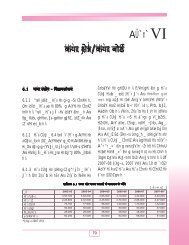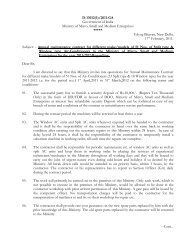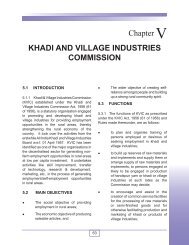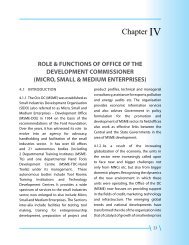Evaluation Study MSE Cluster Development - Ministry of Micro ...
Evaluation Study MSE Cluster Development - Ministry of Micro ...
Evaluation Study MSE Cluster Development - Ministry of Micro ...
You also want an ePaper? Increase the reach of your titles
YUMPU automatically turns print PDFs into web optimized ePapers that Google loves.
Chapter No: 7 – Conclusions nd RecommendationsCHAPTER7CONCLUSIONS ANDRECOMMENDATIONSBefore listing the specific conclusions and recommendations <strong>of</strong> our study it is importantto clearly stress that, at the overall level, our assessment <strong>of</strong> the CDP leads us to thedefinite conclusion, that the programme is most essential, and can be extremelyeffective.It should also be emphasized that it provides the much-needed support for the SMEsector at a time when we are opening up the economy and exposing our small industryto fierce global competition. This programme in fact provides the only ‘safety net’ forsmall and micro enterprises in the country. It is therefore recommended that the efforts<strong>of</strong> the MSME should be fully supported through the provision <strong>of</strong> additional resourcesduring the 11th Plan Period. Since the plan document clearly states its intentionsregarding inclusiveness, further support for this programme is certainly justified. Inwhat follows we highlight the specific conclusions and recommendations <strong>of</strong> this study.7.1 Need for a Scientific Definition <strong>of</strong> a “<strong>Cluster</strong>”A clear definition <strong>of</strong> a cluster is conspicuously absent in the present guidelines <strong>of</strong> the CDPprogramme. This may have led to the identification <strong>of</strong> a very large number <strong>of</strong> clustersfar beyond those which can be taken up considering the present capabilities <strong>of</strong> theinstitutions and functionaries involved. A more focused, feasible and prioritized set <strong>of</strong>clusters needs to be identified for effective interventions. The basic criteria for theselection <strong>of</strong> clusters require the consideration <strong>of</strong> the following issues:• The need to clearly focus on goods producing clusters.• The need to identify those sectors wherein the contribution <strong>of</strong> SMEs are predominantand where traditional skills combined with an abundance <strong>of</strong> locally available inputswhich enables the production <strong>of</strong> goods which can compete nationally andinternationally because <strong>of</strong> their uniqueness and high quality.• <strong>Cluster</strong>s, which are already organized and assisted, by strong associations, unionsand lobbies should be preferred.The need for determining a critical mass <strong>of</strong> viable and functional individual and strictlyindependent units, which have sustained their activities pr<strong>of</strong>itably over the last 5 years.This critical mass should reflect low dispersion and high density ensuring its effectivemanagement. Moreover a high degree <strong>of</strong> homogeneity (in terms <strong>of</strong> size / turnover /product range and other social characteristics) needs to be seriously considered toensure cooperation and collective action between the constituent units.Experts or institutions that have the requisite capabilities, and are capable <strong>of</strong> carryingout this task in a definite time frame, should undertake the identification andprioritization <strong>of</strong> clusters for effective interventions. These institutions should also berequired to conduct the diagnostic study for which standard guidelines should be115
















